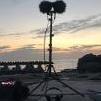-
Posts
99 -
Joined
-
Last visited
Profile Information
-
Location
San Francisco
-
About
As of 2011 I'm practicing film sound and learning about other sound fields.
Recent Profile Visitors
1,517 profile views
-
'Accepts no liability' is lawyerspeak for 'is liable for and trying to avoid that liability'. It is actually sort of a nifty trick that even by signing their 'accepts no liability' thingy I can still sue them for what they were liable for all along.
-

Managing audio gear at Burning Man
Tom Morrow replied to Solid Goldberger's topic in General Discussion
I have done a little bit of sound for film recording at burning man. I organized all my gear beforehand and just took it out of plastic bags for the single event. It was fine but if I were doing it full time nowhere near safe enough. I had the producer rent as much gear as I could. -
The specs on the preamps in the 7xx series are much higher than those of the 6xx and sd says explicitly that the 7xx are better. How much better? Who knows. What I know is that I have never heard or been bothered by recorder hiss with the 7xx series.
-
Check out the Xantrex PROWatt SW series: http://www.xantrex.com/power-products/power-inverters/prowatt-sw.aspx This line just came out year ago and offers the best value for high quality pure sine. I recently verified that I don't get hum using mine with a playback system on set, although I haven't tried a mixer.
-
Indeed, the creation of an inductance loop is my primary concern with looping the extra cable. I like the hair-tie around the transmitter approach, for quick situations where you don't need to thread the a connector bullet through clothing or undergarmets. It['s a shame it has to add extra bulk on top of the transmitter. Securing under the armpit is a good idea that I hadn't considered. Lots of space there, and it's high enough that you can let some extra dangle but still stay under the shirt. So true. Someone told me this a while ago and this is the best piece of advice I've ever heard for getting a good lav placement. The more placements you try on the same actor/outfit, the more you learn. Much more than doing different placements on different actors.
-
I've been experimenting with different methods for taking up extra lav cable, e.g. if the cable is sized for an ankle placement and one places the transmitter on the waist. What I'm doing these days is coiling it up into about a 2" diameter loop, near the belt pack connector. This makes things better in a number of ways: 1. The loop serves as strain relief, so I don't have to worry about talent ruining the connector so much when they are using the bathroom. 2. I generally can adjust the number of loops so there is the perfect amount of slack in the cable so it stays under their shirt without being too tight. 3. No extra tape is needed for securing the wire to their clothes, which generally makes things easier. But I think I might be experiencing slightly worse radio performance as I typically tuck the loop above the belt pack, in the valley between the skin and the antenna. I'm considering either tucking the loop in their pants, or making the loop on their stomach where I normally have a strain relief loop taped to their skin anyway. Just curious how others keep lav cables secured under the clothing.
-
http://www.rodemic.com/accessories/invisilav This thing is Rode's answer to the RM11. I can't imagine why they decided that two slots were necessary. Why make the 99% of people who don't use dual mics carry around the extra material so that people who really do need dual mics don't need to carry around the xtra material of an extra mount? I am curious why folks in this thread seem to not like hiding mics under collars... I've found it a decent place because the triangular space allows a large isolation device like an rm11 or hushlav to be used. That said, recently I've been having better luck with taping mics between buttons. At any rate, I do think it's important to have something to keep adhesive off the microphone and the one thing I don't like about the rm11 is that topstick sometimes gets adhered to the mic through the opening on the bottom back.
-

mic tolerance- is 3db difference between mics a sign of trouble?
Tom Morrow replied to Tom Morrow's topic in Equipment
Good to know. Sanken does make a version of the cos11d called reduced sensitivity which is -9db. I'm sure I don't have that much attentuation. I'm considering returning one of the shorter and one of the longer mics just so that I have a pair with the same levels. It's just easier to remember rules of thumb for level settings when all the mics are the same. -

mic tolerance- is 3db difference between mics a sign of trouble?
Tom Morrow replied to Tom Morrow's topic in Equipment
I did a more accurate test, and determined that the difference is actually 4db. Hmm, that does seem like a significant amount. I used a NTI mr2 to generate sine sweeps, and played through an Adam A7 monitor speaker with the two cos11d's mounted a few inches in front of the speaker cone cap (to overwhelm room modes). I recorded the sine sweep, then switched the connections between right and left, and did another recording (so as to factor out recorder channel differences). In both recordings there was a difference of 4db (on the Adobe Audition meter) between the two mics that I'm wanting to keep, and the consistency shows that it's the mics themselves rather than the hardware or recorder. My biggest concern is that something might have been accidentally done differently between the two mics in how they are wired. Does anyone know if there are any passive components used when wiring the Sennheiser g3 to the cos11d? The cos11d instructions show a resistor and cap in their wiring diagram. -
I ordered a pair of cos11d lav mics. Because I was sent the wrong length, I now have two pairs of cos11d's, until I send one pair back. I decided I'd test them to see how well they match. Testing them side by side by holding the mics in the same spot and speaking, it looks like most of the cos11d's are matched by 1-2db tolerance, but one of them (unfortunately one that I wanted to keep) measures about 3db less (1-2 2db meter segment difference when fed directly into my 744t through MZA900P XLR->Sennheiser adapter). I'm thinking this is within the bounds of normal tolerances, and the two mics sound the same, so even though I am in the return period it's not worth trying to swap one out. I am curious how much would be too much... what amount of signal level variation between two mics would you consider to be a sign of trouble? I don't want to end up with mics that don't match well; it's nice not to have to remember which one is hotter and remember to adjust one 3db differently. I suppose I should a bit more testing to get more accurate about just how much difference there is, before my return window passes.
-

Post your videos of impressive boom handling
Tom Morrow replied to Tom Morrow's topic in General Discussion
Explain the logic fault please kind sir. -
Glen, thanks for sharing your real world experience. That corresponds to my understanding from both experience and theory that the less directional a mic is, the less off axis weirdness of all kinds you get. >Rent an mk4 and experience yourself. You will find Out that your expectations on one mic are too high. I think I may not have been clear... the reason I listed all those different tasks was because I wanted to show that there are some valid reasons for going wider than an mk41 or 416. As Glen later agreed. I was reacting to the people who seemed to be saying "just stick with the same directional mic and get better technique" instead of choosing wider mics for wider soundfields. My point was that different mics have different uses, but it got interpreted as "I'm looking for one mic to solve all my problems" which is the opposite of what I was saying. I'm off to do some recording...
-
Jan, thanks for the advice. I do need to work on networking. And agreed that most of the sound mixers here in San Francisco I've worked with do other things in addition to narrative film work; a lot of corporate work and some live or studio sound, as well as other set work like the lighting that I do. I wish there were something like the CAS here in Northern California; I'm considering joining and driving down to LA every now and then for things like the parade of carts or workshops. Marc, good points. Getting different actors in different shots and then slipping their dialog onto the wider shots does typically solve most of these issues, but as you well know there are always exceptions. When I'm doing the one-man-band thing I usually can't effectively monitor multiple wires well enough to know for sure if we got a solid recording or whether we need to retake, which is why I tend towards the boom: since it's all in one channel I can monitor if the recording is going well or not. And the lower budget productions that I typically work on often don't have post sound people with the time, experience, and budget to sort out mulittrack multitake recordings as well as a dedicated dialog editing team would in Hollywood. I totally get why having a dedicated mixer/boom/utility team is useful, but I'm usually not in that position yet. Horses for courses as they say!
-

Post your videos of impressive boom handling
Tom Morrow replied to Tom Morrow's topic in General Discussion
I'm reading Ric Viers Location Sound Bible right now. He's got a pretty good chapter on boom technique. One of the tips he gives that makes a lot of sense to me is to point the boom mic towards the sternum (chest) rather than the mouth. That has the effect of feathering the sound from the mouth into the slightly off-axis part of the polar sensitivity, where small misalignments don't change the frequency response as much as when you are right on axis. And it also gives the sound a bit more low frequency sound from the chest to balance out the fact that interference tube mics aren't as directional at low frequencies. I'm going to experiment with that approach. -
Agreed and I'm honored to hear it. The biggest limitation of doing most gigs as a one man band is that I miss out on learning from others. I seek out opportunities to work with sound people who have more experience. Working on set lighting is also useful because I get to observe other sound people doing their thing. I continue to take on work as an extra to get on the bigger sets like HBO Looking, NBC Trauma, and Moneyball so I can observe the soundies. The wide-polar mics that I'm looking to test out are: mk2 omni, mk4 cardioid, mk22 open cardioid, mk21 wide cardioid, and the MKH40. Thanks folks.

.png.279748a58a2b862b7aa5f3b84126e232.png)



